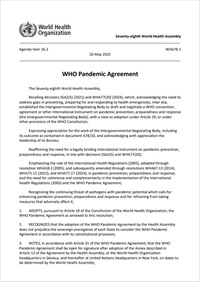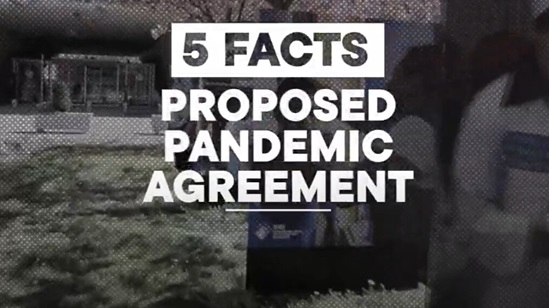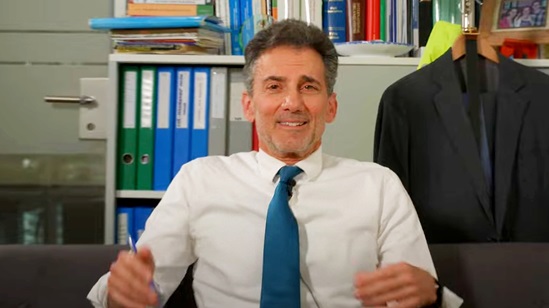A health worker puts on personal protective equipment before entering an ICU for COVID-19 patients at the St. Orsola-Malpighi Polyclinic in Bologna, Italy.
WHO Pandemic Agreement
The WHO Pandemic Agreement was adopted by the World Health Assembly on 20 May 2025, marking a historic moment for global public health. The devastating impact of the COVID-19 pandemic revealed significant gaps and inequities in the world's ability to prevent and respond to health emergencies, prompting nations to take action. Launched in 2021, the negotiation process involved three years of intensive work by governments, in consultation with relevant stakeholders and experts. The aim of the Intergovernmental Negotiating Body established for this process was to draft and negotiate a WHO convention, agreement or other international instrument on pandemic prevention, preparedness and response, that would culminate in a legally binding international instrument designed to make the world safer and more equitable in the face of future pandemics.
Following its adoption, the next crucial step is for an Intergovernmental Working Group (IGWG) on the Pandemic Agreement to negotiate the details of the Pathogen Access and Benefit-Sharing (PABS) system, which will form an annex to the Agreement. Once this annex is adopted by the World Health Assembly, the full Agreement will be open for countries to sign and ratify according to their own constitutional processes. The Agreement will officially enter into force 30 days after 60 countries have ratified it.
The WHO Pandemic Agreement outlines a comprehensive framework to help countries prevent, prepare for, and respond to future pandemics, built on principles of equity, solidarity, and respect for national sovereignty. The Agreement covers key areas, including strengthening disease surveillance and a One Health approach; strengthening health systems; safeguarding the health and care workforce; coordinating research and development; improving local production capacity, including through technology transfer; better coordination across governments and societies; improved communiation with the public; stronger international cooperation; and sustainable financing.
A central pillar is the Pathogen Access and Benefit-Sharing (PABS) System, which will aim to ensure the rapid and timely sharing of pathogens with pandemic potential for public health purposes and, on an equal footing, the rapid, timely, fair and equitable sharing of benefits arising from the sharing and/or utilization of these materials and sequence information based on public health need.
A Global Supply Chain and Logistics Network, coordinated by WHO, will be established to ensure pandemic-related health products are distributed rapidly and equitably. The Agreement also establishes a Coordinating Financial Mechanism to support strengthening and expanding pandemic prevention, preparedness and response capacities in countries. The Agreement strongly reaffirms that it does not give WHO authority to impose measures such as lockdowns or vaccine mandates on any country.
Implementing the WHO Pandemic Agreement will be a collaborative of the State Parties to the instrument, involving coordinated action at national, regional and international levels. A Conference of the Parties will be established as the main governing body, meeting regularly to review progress, make decisions, and promote effective implementation. Each country is encouraged to consider ratification of the WHO Pandemic Agreement, in line with its domestic practices, and is responsible for integrating the Agreement's goals into its national plans and policies. This includes developing multisectoral national pandemic prevention and preparedness plans and strengthening regulatory systems for approving health products.
The WHO Secretariat will provide technical support and facilitate cooperation among the parties to the instrument, but all implementation remains under the control and authority of the sovereign states who are parties to the Agreement. Through its effective implementation, the WHO Pandemic Agreement will seek to build a more equitable, inclusive, transparent and accountable global health system that can better prevent, prepare for and respond to future health emergencies.






